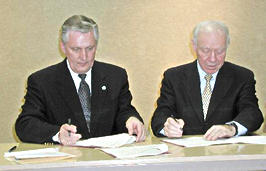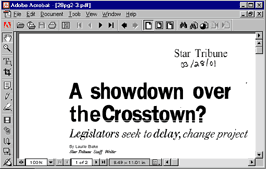 |
 |
 |
Agreement
kicks-off new transportation research lab |
 |
 |
 |
|
Commissioner
Elwyn Tinklenberg (left) and U.S.
Rep. Jim Oberstar were two of the partners who signed
an agreement on March 26 creating a new transportation
research lab at the University of Minnesota-Duluth.
|
Mn/DOT will
partner with the University of Minnesota-Duluth and the Center
for Transportation Studies to open a new transportation research
lab at UMD, Commissioner Elwyn Tinklenberg announced March
26.
Called the Northland Advanced Transportation
Systems Research Laboratory, the new research center will
focus on winter transportation systems and the transportation
needs of small urban areas, he said Monday at a press conference
in Duluth.
"Mn/DOT places a high priority on
innovation with our Moving Minnesota initiatives," Tinklenberg
said. "In addition to helping support the development
of laboratories at UMD, we can provide a real-world laboratory
with our transportation system."
Some of the projects envisioned for the
research lab include testing pavement sensors in cold weather
conditions and researching on-demand fleet routing systems
for snowplow operations.
Also attending the press conference were
U.S. Rep. Jim Oberstar, long-time transportation advocate
who helped get federal funds for the lab, UMD Chancellor Kathryn
Martin, and other university representatives.
Duluth District Engineer Mike Robinson
said, "The research done at the new facility will benefit
all motorists by making our roads safer. My staff and I are
committed to working closely with UMD to conduct research
and test new technologies and strategies."
The research lab is estimated to cost
$3.7 million, and will be built at a Mn/DOT weigh scale site
on southbound I-35 near Carlton, said Roberta Dwyer, consultant
program project manager, Duluth district. This will allow
for testing of devices both on an actual roadway and on a
controlled track, she noted.
The lab is expected to be ready by late
summer 2001.
In related news, Mn/DOT last week approved
16 new research projects for fiscal year 2002, many of which
include partnering with CTS. Watch Mn/DOT Newsline
for more information about these projects.
For more information about the new transportation
research lab, contact Roberta Dwyer at 218/723-4960, ext.
3504.
By Chris Joyce
Photo by Maureen Talarico
|
|
back

|
 |
House
committee passes three bills to delay I-35W/Highway 62 improvements
project |
 |
 |
Improvements
to the I-35W/Highway 62 Crosstown Commons area in Minneapolis
would be delayed if any of the three bills approved by a House
committee this week passes the full Legislature, said Dick
Stehr, Metro Division engineer.
The House Transportation Policy Committee
gave the green light to the bills on March 27. The proposed
measures would delay improvements to I-35W/Highway 62 for
varying reasons, but would require Mn/DOT to do additional
work before construction could begin.
If delayed, the project, which is scheduled
to begin this August, could lose $4.4 million in federal money
targeted for it. This stretch of road carries approximately
250,000 vehicles per day and has an accident rate nearly three
times that of the rest of the metro interstate system.
The bills were referred to the House Transportation
Finance Committee for further action.
For more information about this and other
legislative issues affecting Mn/DOT, contact Joe Hudak at
651/297-5149, click on Mn/DOTís weekly
legislative summary or check
out its Government
Relations Web site.
|
|
back

|
 |
Fatal
vehicle/train crashes drop dramatically in 2000 |
 |
 |
The number
of persons killed in vehicle/train crashes at railroad crossings
declined from 11 in 1999 to 4 in 2000, according to Al Vogel,
director, Office of Freight, Railroads and Waterways.
In addition, the total number of vehicle/train
crashes declined from 93 in 1999 to 83 last year. Non-fatal
injuries also dropped. There were 52 injuries reported in
1999 while 37 injuries were reported last year.
In 1998, there were a total of 105 such
crashes. Eight of those incidents resulted in nine fatalities.
"We are encouraged by the decrease
in crashes and fatalities," Vogel said, "but we
still have a long way to go to eliminate them. We must increase
our efforts and the public must increase its alertness and
get over its need to take chances with oncoming trains at
rail crossings."
Vogel said the overall drop in crashes
and the decrease in fatalities may stem from the departmentís
increased efforts to improve railroad crossing safety during
the past decade.
Mn/DOTís efforts include, he said, a comprehensive
effort to improve roadway marking and signing at crossings,
the installation of more automated signals with lights, bells
and gates. They also include the departmentís work with the
railroads to improve crossing safety throughout the entire
length of major rail corridors and joint efforts with the
Minnesota Safety Council and the railroads to increase public
awareness about rail crossing safety.
For more information, check out the Office
of Freight, Railroads and Waterways
Web site, or contact Tim Spencer, Office of Freight, Railroads
and Waterways, 651/296-2849.
By Craig Wilkins
|
|
back

|
 |
Providing
advantages for transit: workshop helps identify needs on funded
corridors |
 |
 |
Incorporating customer needs into planning
has become more than a "mantra" for Mn/DOT planners.
One recent example is the Interregional
Corridor PlanningĖTransit Workshop held March 22 in Chaska.
At this workshop, Mn/DOT planners and facilitators met with
transit managers from around the state. Their goal was to
identify transit needs and issues on corridors funded by last
yearís Moving Minnesota legislation, according to Al Pint,
Mn/DOT interregional corridor manager for Districts 1, 2,
3, 4 and northern Metro Division.
Transit providers such as Minnesota Valley
Transit and St. Cloud Metro Transit sat down in breakout workgroups
with project managers from the Metropolitan Council and six
Mn/DOT districts/divisions. Facilitators for each workgroup
helped the 37 attendees to sift through data, needs and concerns
to identify major issues that should be addressed in planning
improvements for each corridor.
Attendees brought to the workshop information
such as:
- The population base they serve and
the service levels they currently deliver;
- The growth they anticipate in service
needs and population for three target dates: 2005, 2010
and 2020;
- The future facilities they anticipate
needing, such as park and ride lots, garages, bus shoulder
lanes, and transfer facilities (where customers transfer
from one mode of transportation to another); and
- Recommendations they have for facilities
that can be shared among agencies and transportation modes.
"The workshop was a huge success,"
said Pint. "It provided the initial opportunity for the
transit providers to provide input into the IRC management
plans and to identify the key issues along the corridors."
For more information, contact Al Pint
at 651/282-6298. In addition, check out Mn/DOTís Web site
to learn about the interregional corridors funded by last
yearís Moving
Minnesota legislation. See also
the Greater
Minnesota Transit Plan.
|
|
back

|
 |
Mn/DOTís
performance management process cited in Governing magazine
|
 |
 |
 |
|
Governing
magazine interviewed Woody Woodruff, Mankato
district highway maintenance supervisor, about Mn/DOT's
performance management process.
|
Mn/DOTís
performance management process recently received national
attention, reports Cathy Walz, Mn/DOT training manager, Office
of Human Resources.
Woody Woodruff, Mankato district highway
maintenance supervisor, was interviewed for a Governing
magazine article about job performance reviews. The article
appeared in the magazineís March 2001 issue.
"Itís good to have a system that
relates to all employees within the agency, " Woodruff
told Mn/DOT Newsline. Besides having good technical
skills, Woodruff said that employees need to treat one another
with respect and get along with co-workers and customers.
He believes Mn/DOTís new performance management process takes
those factors into consideration. Woodruff uses the process
to talk with the more than two dozen employees he supervises
and finds the process promotes dialogue with his employees.
Mn/DOT unveiled its new performance management
process in October 1998, focusing on individual competencies,
Walz said. Technical skills are one component of any job;
leadership, people management and organizational knowledge
are some of the other competencies. The new system provides
supervisors with a framework to discuss goals and performance
with employees. It has helped move the traditional yearly
performance appraisal to a broader discussion between supervisors
and their employees to clarify expectations, she said.
Walz noted that the Mn/DOT performance
management process has been highlighted in several articles,
including the Harvard Business Review.
For more information, click on the Governing
article
or on Mn/DOTís performance
management Web site, or contact
Cathy Walz at 651/296-3101.
By Sue Stein
Photo by Rebecca Arndt
|
|
back

|
 |
New
on the Web: newspaper clippings at your fingertips
|
 |
 |
 |
|
News
is just a click away with online clippings.
|
Daily newspaper
clippings from the Minneapolis StarTribune and the St. Paul
Pioneer Press are now available on the departmentís intranet,
compliments of the Mn/DOT Information Center.
The Information Center staff searches
the two daily papers for transportation-related articles including
news stories, letters-to-the-editor and editorials. The articles
are then scanned and posted on Mn/DOTís internal Web site
every MondayĖFriday morning.
"The newspaper clipping service is
nothing new but the online format is," notes Cathy Sullivan,
Information Center manager. "Until now the clippings
were copied and distributed to a limited number of managers
and public affairs coordinators. This new technology makes
the information available to all employees with intranet access."
It also saves paper. The staff clips an
average of five to six articles every day. With a printed
distribution of more than 80 employees, the clipping service
uses four or five thousand sheets of paper in a week.
The articles are posted as PDF (Portable
Document Format) files, which allow users to select specific
text or search within documents for key words. An index is
created for each day, allowing users to quickly scan the dayís
news and select any stories they would like to read.
Check out the online
clippings at on the Office of
Communications and Public Relationsí Web site. Note: to access
the clippings, you will need to use Adobe Acrobat software.
If you need help with the program, contact your local information
technology support staff.
By Kay Korsgaard
|
|
back

|
 |
National
Transportation Conference in Twin Cities |
 |
 |
Volunteers are needed to help plan the
Womenís Transportation Seminar National Conference, which
will be held May 15-17, 2002 in Minneapolis.
WTS is seeking volunteers for the following
conference planning committees: arrangements, budget and finance,
exhibits, fundraising, hospitality, programs, protocol, publications,
publicity, registration and technical tours, according to
Deanna Keltner, Office of Investment Management and president
of the local WTS chapter.
Men and women can take advantage of this
opportunity to promote transportation by joining WTS and working
on the conference. Commissioner Elwyn Tinklenberg is a member
of WTS, and Margo LaBau, chief of staff, last year was named
"Woman of the Year" by the local WTS chapter.
For more information about WTS, contact
Keltner at 651/297-5122 or at deanna.keltner@dot.state.mn.us.
For conference information, contact Laurie McGinnis, conference
chair, at 612/625-3019 or at mcgin001@cts.umn.edu.
By Sue Stein
|
|
back

|
 |
Question
of the Week: starting with the same definitions |
 |
 |
Whether
itís a business issue or interpersonal communication, it helps
to have a common understanding of what words mean to the user
and the listeneróespecially when using "buzzwords."
Many of Mn/DOTís buzzwords are specific
to transportation or to the organization. Others come from
the computer world, business, sports, and so on. Sometimes
these buzzwords transfer easily; sometimes they donít, depending
upon an individualís unique perspective and background.
In this weekís Question
of the Week, a reader asks for
Commissioner Elwyn Tinklenbergís definition of a word that
Mn/DOT uses often these daysó"customer."
|
|
back

|
|
|
 |
|


